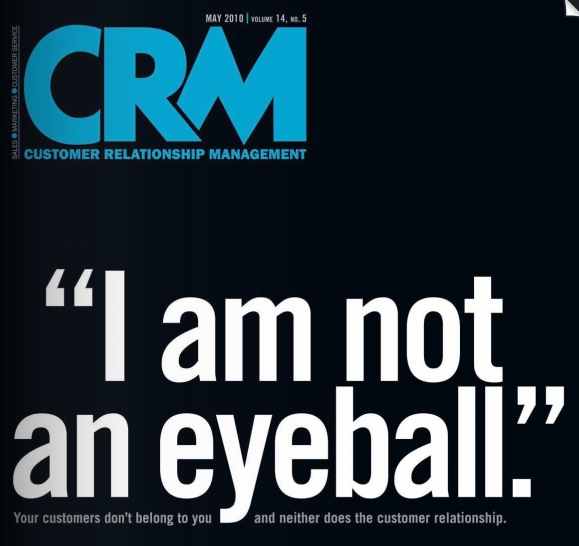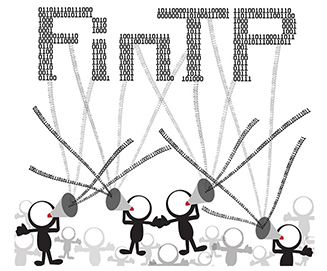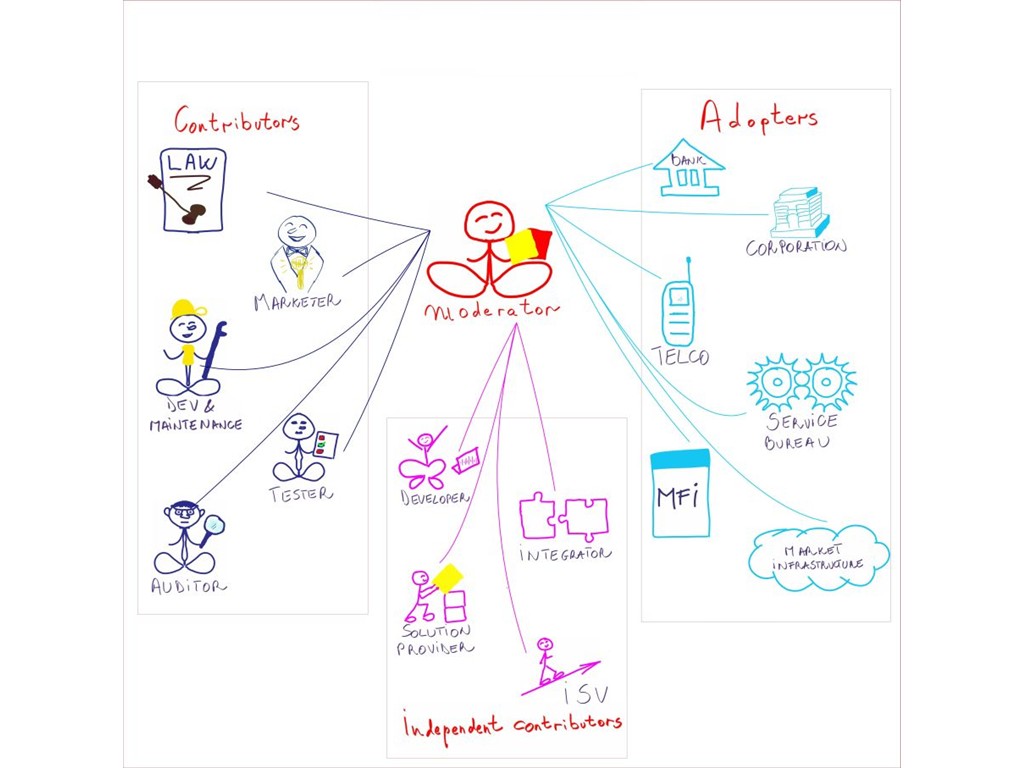
Many years ago, in a column about journalism, William Safire surfaced a tasty bit of inside jargon: the word “MEGO.” It stood for “My Eyes Glaze Over.” Any story that was too important not to run but too dull to interest anybody was a MEGO. His example of a one-word MEGO was “eurodollars.”
Lately a three-word MEGO has come up in conversations about VRM (itself, admittedly, a MEGO): double-entry bookkeeping. As it happens I have some source material for those conversations, in the form of a chapter of The Intention Economy that didn’t make it into the book because, well, it was a MEGO.
It’s still too important not to write about, however, even if it is too dull to interest more than a few people for a few minutes at a time. And hell, that’s why we have blogs, no?
What makes double-entry bookkeeping important is that maybe it can save our asses from what computing did to our hands-on knowledge of how business works—or ought to work—in a hearty economy. Hence the hope behind the headline above.
So, rather than let my last draft of the chapter languish on my hard drive for another few years, here it is.
— Doc
P.S. A prettier and newer version of this is here in Medium.
Balances
Books should be closed each year, especially in partnership because frequent accounting makes for long friendship. —Luca Pacioli
THE ARGUMENT
Networked markets connect two ways: between businesses and people, and between the functional parts of companies. These connections have long been facilitated through double-entry bookkeeping, the deep virtues of which have mostly been ignored or forgotten in our digital age. If we recall what double-entry bookkeeping did, and can do again, we may have another useful path toward The Intention Economy.
THE ORIGINAL BUSINESS SCIENCE
Modern banking is seven hundred years old. It was invented in early Renaissance Italy, and modeled at its start by the Medici bank, which lasted from 1397 to 1494.[ii] One fo those early Italian banks, Banca Monte dei Paschi di Siena S.p.A., founded in 1472, is still around.
Modern double-entry bookkeeping was also established in that time, though it dates back farther. The first major published work on the subject was Summa de arithmetica, geometria, proportioni et proportionalita (Venice: 1474), a textbook by Fra Luca Pacioli, a Franciscan monk, doctor of divinity, and mathematician on the faculty of several universities [iii]. Within Summa is a Tractatus de Computis et Scripturis: the first complete description of double-entry bookkeeping, a system of mathematics which Pacioli treats as equal to Euclid’s in relevance to the everyday world.
Summa was Pacioli’s second published work.  The first, Tractatus mathematicus ad discipulos perusinos, is a six hundred page textbook in which sixteen sections are devoted to “merchant arithmetic.” [iv] In 1509, Pacioli published both Geometry (a Latin translation of Euclid’s Elements) and Divina proportione, illustrated with sixty drawings by Pacioli’s student and friend, Leonardo da Vinci [1]. Although Pacioli and Leonardo did not begin working together until 1496, it is likely that da Vinci’s Vitruvian Man (on the right), drawn in 1487, was informed by Summa de arithmetica, a copy of which da Vinci possessed.[v] (Pacioli also applied the divine proportion (better known as the golden ratio) to typeface design. The “M” in the Metropolitan Museum of Art logo is Pacioli’s[vi])
The first, Tractatus mathematicus ad discipulos perusinos, is a six hundred page textbook in which sixteen sections are devoted to “merchant arithmetic.” [iv] In 1509, Pacioli published both Geometry (a Latin translation of Euclid’s Elements) and Divina proportione, illustrated with sixty drawings by Pacioli’s student and friend, Leonardo da Vinci [1]. Although Pacioli and Leonardo did not begin working together until 1496, it is likely that da Vinci’s Vitruvian Man (on the right), drawn in 1487, was informed by Summa de arithmetica, a copy of which da Vinci possessed.[v] (Pacioli also applied the divine proportion (better known as the golden ratio) to typeface design. The “M” in the Metropolitan Museum of Art logo is Pacioli’s[vi])
In The Printing press as an agent for change, Elizabeth Eisenstein calls Pacioli “a pioneering public lecturer and science-writer whose work was ransacked by others for a century or more”[vii], and “probably the most wide-ranging, influential and forceful advocate of mathematics for the layman during the first century of print,”[viii] with influences on Dürer, Kepler, Pascal and others. She continues,
Less often noted is the way this fifteenth-century encyclopedic work linked double-entry bookkeeping and business arithmetic with Pythagorean harmonies and the music of the spheres… Pacioli’s Summa represents something of a landmark. Within the covers of this one book can be found all the varied between schoolmen and mysteries of double-entry bookeeping for mechants, so too he underlined the importance of the study of Euclid for Surveyors, architects and other ‘universal men.’ [ix]
In “The Beauty of Double-Entry Bookkeeping and its Impact on the Nature of Accounting Information,” (written in celebration of Summa’s 500th anniversary), Yuri Ihri writes, “the essence of double-entry bookkeeping is not just a contrast between balance sheet accounts and income statement accounts, but, more generically, a contrast between state accounts and explanatory accounts, with the latter explaining changes in the former.” Note that these are two different things. Ihri continues,
This essence, which is stated here in the form of axioms of double-entry bookkeeping are done not globally but myopically and incrementally, which is of double-entry bookkeeping on the nature of accounting information is analyzed accounts. Turning somewhat philosophical, “difficulty, efficiency and originality” are regarded as being the three ingredients of intellectual beauty. Double-entry bookkeeping is found to have all three and to be a “thing of beauty” indeed, as stated by Goethe, Cayley and Sombart, whose quotes are given at the beginning of the paper.[x]
Those quotes are,
“What a thing it is to see the order which prevails throughout his business! By means of this he can at any time needing to perplex himself in the details.What advantages does he derive from the system of bookkeeping by double-entry! It is among the finest inventions of the human mind.” (Goethe, 1824., Vol. I, Book 1, Chapter X. p. 28, translated by Thomas Carlyle). “The Principles of Book-keeping by theory which is mathematically by no means uninteresting: it is in fact like Euclid’s theory of ratios an absolutely perfect one, and it is only its extreme simplicity which prevents it from being as interesting as it would otherwise be. (Cayley, 1907).
“Double-entry bookkeeping is bourne of the same spirit as the system of Galileo and Newton… With the same means as these, it orders the phenomenon into an elegant system, and it may be called built on the basis of mechanistic thought. Double-entry bookkeeping discloses to us the cosmos of the economic world by the same method as, later, the cosmos of the stellar universe was unveiled by the great investigation of natural philosophy… One can scarcely conceive of capitalism without double-entry book-keeping: they are related as are form and context. It is difficult to decide, however, whether in double-entry book-keeping capitalism provided itself with a tool to make it more effective, or whether capitalism derives from the ‘spirit’ of double-entry book-keeping”. (Sombart, 1928. Vol. II, Part I, p. 118-9).[xi]
In spite (or perhaps because) of these cosmic qualities, nothing in Summa reads strange to a businessperson today. Pacioli describes journals, ledgers, inventories, accounts receivable and payable, trial balances, income, expenses, trades and exchanges, salaries, duplicate receipts, “sales for cash or on time with brokers’ commissions,” profit, loss and other concepts and practices that have hardly changed in most of a millennium. His instructive tone is also familiar:
He who wants to know how to keep a ledger and its journal in due order must pay strict attention to what I shall say. To understand the procedure well, we will take the case of one who is just starting in business, and tell how he must proceed in keeping his accounts and he may find each thing in its place. For, if he does not put each thing in its own place, he will find himself in great trouble and confusion as to all his affairs, according to the familiar saying, Ubi non est ordo, ibi est confusio (Where there is no order, there is confusion).
Central to bookkeeping — then and now — are its three books: the memorandum, the journal and the ledger. Here is a compression of Pacioli’s teachings, taken from a series of chapters in Summa:
The memorandum book… is a book in which the merchant shall put down all his transactions, small or big, as they take place, day by day, hour by hour. In this book he will put down in detail everything that he sells or buys, and every other transaction without leaving out a jot; who, what, when, where, mentioning everything to make it fully as clear as I have already said in talking about the Inventory, so that there is no necessity of saying it over again in detail.
…The bookkeeper will put everything in order before he transcribes a transaction in the journal. In this way, when the owner comes back he will see all the transactions, and he may put them in a better order if he thinks necessary. Therefore, this book is very necessary to those who have a big business.
…After you have proceeded on this way through all the accounts of the Ledger and Journal and found that the two books correspond in debit and credit. It will mean that all the accounts are correct and the entries entered correctly.
…After you have finished checking off the Journal, if you find in the Ledger some account or entry which has not been checked off In debit or credit, this would indicate that there has been some mistake in the Ledger… and you shall correct this error.
Throughout Summa, Pacioli invokes the context of balance. Balancing books also balances a functioning business in the world. It is an exercise as normal and necessary as walking upright on two feet.
MOMENTS IN DOUBLE-TIME
In 1913 Charles M. Van Cleve self-published Principles of Double-Entry Bookkeeping. His purposes were to “to explain the principles which underlie the art of accounting by the double-entry method,” and to solve “the problem of placing double-entry bookkeeping on a rational basis”:
As a rule, the study of a useful art has a certain value as mental discipline; the art of accounting is the one exception to the rule. Aside from the so-called occult sciences, there is nothing which so tends to bewilder the mind and to dull the faculty of reason as the study of double-entry bookkeeping in the form in which it is customary to present it.[xii]
In our time, double-entry bookkeeping has fallen out of favor after a six century run. Today accounting is done on computers, with software packages, the most popular of which is Quickbooks, which boasted a 94.2% share of retail units in the business accounting category in 2008. [xiii] Quickbooks is built for single-entry bookkeeping. Yes, you can get it to do the double-entry kind, though not in ways that make sense to double-entry stalwarts. One of those is Jim Reverend, who blogged this in 2006:
A few years ago, just for fun, I taught myself Double Entry Accounting. I found the whole process very interesting and was intrigued by the fact that so many people would go through so much trouble to learn what amounts to nothing more than a hunk of theory and procedures developed over 500 years ago that have changed very little since then. I really enjoyed the simplicity of the system and the obvious nature of its rules.
I assumed that keeping track of my business’ finances using accounting software would be a relatively straight-forward task, so I set out in search of this software. Quickbooks came highly recommended by almost everyone I asked so I purchased the “Pro” version. $150 later and 10 minutes into using the software and I found myself angry, confused, and sitting in a pile of my own hair.
While Quickbooks may indeed perform Double Entry Accounting in the background, using it is nothing like the simple system of checks and balances that I learned. Quickbooks breaks everything down into common business aspects and concepts and takes the accounting out of it as much as possible. This is great if you don’t know accounting and your business doesn’t deviate too far from the norm. However, if you intend to make even the slightest curve away from a “normal” usage pattern, you’ll find that the software gets in your way more than anything. So I’ve found that my knowledge of Double Entry Accounting isn’t nearly as useful as I thought it would be and, instead, I’m now giving myself a profanity-studded crash-course in manipulating “Quickbooks” into doing what I want.[xiv]
When we go back to Van Cleve, we begin to see why Reverend got so frustrated with Quickbooks’ new double-entry conventions:
The whole difference, and the only difference, between the two systems of accounting is in the fact that single-entry bookkeeping always uses literal language, while double-entry bookkeeping always uses figurative language except when speaking of persons. As soon as one understands the figurative language which it uses, double-entry bookkeeping is just as simple as single-entry bookkeeping — and much more compact.
In single-entry bookkeeping, cash means cash. Merchandise means merchandise. Interest means interest. Expense means expense. But in double-entry bookkeeping cash does not mean cash; it means the imaginary person who owes the amount of the cash. Merchandise does not mean merchandise; it means the imaginary person who owes the amount of the merchandise. Interest does not mean interest; it means the imaginary person who owes or is owed the amount of the interest. Expense does not mean expense; it means the imaginary person who owes the amount of the expenses. Net Capital does not mean net capital; it means the person (real in the case of an individual owner, imaginary in the case of a firm or a corporation) who is owed or owes the amount of the net capital.
This kind of abstraction may seem to detach meanings, but instead they are useful generalizations. Quickbooks insists on a specificity that loses the virtues of abstraction. Here’s Reverend again:
If you want to “pay a bill” (an annoying feature of Quickbooks that you are all but required to use) you will be annoyed every time you do unless you have a “Credit Card” defined. I don’t have a business credit card. I don’t really need one. Despite this, I ended up making a fake “Credit Card” account just to get it to shut up.
You can only pay bills by “Check” or “Credit Card”. You cannot use “Cash”, “Accounts Payable” or “Owner’s Equity” to do so. Oftentimes, I “pay bills” with my personal funds which are not tracked along with my business accounts. So, in order to work around this, I had to create a “Credit Card” account for myself at the “Bank of Daniel”. Any expenses that are paid with personal funds are treated as charges on the “Bank of Daniel” “Credit Card”. Every now and then (once a month, probably) I’ll submit a transaction to pay off the debt on this “Credit Card” with funds from “Owner’s Equity”.
Van Cleve’s case was for all-rational double-entry bookkeeping: “What this treatise has accomplished is to prove that double-entry bookkeeping is a rational process and therefore does not involve the necessity of using irrational language.” [xv] His final paragraph is a Victorian huff:
When accountants learn to use words in their proper sense, when they learn to say asset when they mean asset, liability when they mean liability, and net capital when they mean net capital, they will be surprised to find how much higher a place their occupation will hold in public esteem.
Van Cleve won. Pacioli lost. In place of double-entry bookkeeping’s well-abstracted “irrational” language is an all-literal vernacular, formalized in Quickbooks. Gone also is what Van Cleve failed to appreciate, even if he understood it: that bookkeeping isn’t just about keeping books, or recording profits and losses. It’s about the business’s own narrative. That narrative maintains the integrity of the business itself and its connection to the world. It’s also a way to maintain the form of coherence we call sanity. We have, as they say, lost it.
This was an observation made by Dan Palanza more than three decades ago.
MAKING THE CONNECTIONS
I first met Dan Palanza in September 2010, when I was in Woods Hole with friends. One of those was Andy Maffei, a scientist with the Woods Hole Oceanographic Institution. Andy had pulled together a small group to hear Dan share what he had learned about bookkeeping, a subject Dan had studied intensively over the last three decades. In recruiting me, Andy wrote, “Dan has convinced me that Book-keeping is actually a language that is used to describe energy transfers between two entities where there are two paired components, one physical and one intellectual. It is a way both to describe that transfer and to analyze and represent the balance inherent in such transfers.”
While Dan’s topic is book-keeping [2], his subtopics include thoughts and works by Einstein, Lewis Hyde, Denise Schmandt-Besserat’s history of counting and writing, four kinds of arithmetic, computing, software, linguistics, the construction business, and the financial meltdown. The list is actually much longer, but that gives you a sense of Dan’s scope. Dan’s story begins in the 1950s, when he worked at General Electric:
In those days the company had a well-refined double-entry book-keeping framework. It ran a complex manufacturing operation building steam turbines, generators and ship propulsion systems. These manufacturing operations were run by a book-keeping journal that used mimeograph business cards as control. The control cards carried production operations as shop work-orders and were returned with accounting data telling which pieceworkers completed each operation. When the journal data was used to generate ledger reports, those reports were detailed to treat each shop foreman as an individual business within the business. The technical term for this level of book-keeping is “cost accounting.” Note that cost accounting and production operations were connected in this system, which was still the one Pacioli described. What GE also had was a network business architecture. The pieces were all functionally connected, and these connections transcended corporate hierarchy.
For many years after leaving GE, Dan didn’t give book-keeping much thought, beyond remembering with admiration how it worked. By the 1970s he had returned to his family’s construction business, and by 1979 was specializing in energy-efficient homes. The first personal computers were in the world then, so Dan decided to get an Apple II and a book-keeping program, in faith that he would find in the program the same deep cost accounting methods he had learned at GE twenty years earlier. “I assumed that book-keeping was book-keeping,” he said, “even if it was done on a PC. But it didn’t work out that way.” What Dan found was that accounting systems on early PCs were flawed:
Essential pieces were missing. There no cost-accounting, no network architecture. I saw problems not only for my own business, but for the whole financial system that would be built on top of inadequate programs like the ones I saw at the time, and on through the 1980s. Even though these were business applications, they were built to serve isolated needs: filling out checkbooks, paying taxes, putting stuff in lightweight databases and spreadsheets. None of them implemented the journal | ledger pattern, which is fundamental to a proper book-keeping framework. They skipped the journal entirely, posting transactions directly into a relational database, which was fine for doing what databases do, but what databases don’t includes double-entry book-keeping.
In 1985, when Dan’s daughter Laureen opened a small business in Falmouth, Dan decided to learn programming, and developed his own full cost-accounting system with a network business architecture. Laureen’s place became Dan’s own little General Electric. Then, after Laureen’s was sold in 1995, Dan set about re-constructing book-keeping’s universal framework of rules. Like Pacioli, Dan mission was to understand and codify the fundamentals of an applied science. Unlike Pacioli, Dan was operating in a world where the science was no longer applied. So Dan got a Small Business Innovative Research (SBIR) grant from the National Science Foundation in 1998, and competed his project in 2003. He did this alone, since there was no peer group for his work, and no standing interest in what otherwise looked like an utterly mundane subject. Since then Dan has been studying Einstein, Gödel, von Neumann, Heisenberg and other Deep Dudes, making connections between their work—both finished and unfinished—and book keeping, plus three other subjects that explain why this chapter is here: the market, the Internet and the commons.
If we want the Internet’s commons to function fully as a marketplace, Dan says, we’re going to need double-entry bookkeeping. Put more simply, business will need to become sane again. We don’t need Dan to tell us business is insane now. But it might help to report that Dan saw the loss of double-entry book-keeping writ large in the dot-com and housing industry meltdowns, both of which he predicted years before they happened.
He doesn’t blame business leaders or governments for not getting it. He blames a lack of tools. Business without double-entry book-keeping is like mathematics without calculus. You still can do a lot, but you’re crippled if you want to look at—say, change. Not that Dan is a pessimist. He sees the lack of book-keeping tools as an opportunity. “If we bring back double-entry book-keeping—to business, to the commons, to the Internet, to the marketplace, and to our everyday lives—we’ll start another renaissance.”
DEMAND AND SUPPLY
The expression “supply and demand” was first coined as “demand and supply” by James Denham-Steuart in An Inquiry into the Principles of Political Oeconomy, written in 1767. [xvi] In his Inquiry, Denham-Steuart says of demand, “it must constantly appear reciprocal. If I demand a pair of shoes, the shoemaker either demands money, or something else for his own use.” He goes on to describe seven qualities of demand, the sixth of which is, “The nature of demand is to encourage industry.”
In The Wealth of Nations, published nine years later, Adam Smith wrote, “The real and effectual discipline which is exercised over a workman is that of his customers. It is the fear of losing their employment which restrains his frauds and corrects his negligence.” What these two bright bulbs of the Scottish Enlightenment both illuminated—the necessity for strong connections between customers and companies—fell into darkness in the Age of Industry. As the mass market replaced the literal one, the importance of individual customers to large businesses diminished. Actual conversation between company and customer was a cost to be minimized, rather than a source of intelligence and discipline.
SO, THEN
In recent years we have seen many ways in which bridges between customers and companies can be built, some of which we reviewed back in the Asymmetrical Relations chapter. But none of these are more than partial systems. And none of them take full advantage of the Net’s nature as a commons, and as a marketplace. Which means there are many opportunities ahead of us—especially if we take a few lessons from our Italian and Scottish teachers.
Footnotes
[1] Pacioli was also the first to note Leonardo’s left-handedness. In De viribus quantitatis (Ms. Università degli Studi di Bologna, 1496–1508), Pacioli says his buddy “wrote in reverse, [his script] is left-handed and could not be read except with a mirror or by holding the back of the sheet against the light.” (Carmen C. Barnbach, “Leonardo, Left-Handed Draftsman and Writer.” Special Exhibition, Metropolitan Museum Of Art, 2003.)
[2] Dan prefers the hyphenated spelling, which is the original form, though less widely used today. So, when referring to Dan’s background, thinking and work, I use his spelling.
Endnotes
[i] John B. Geijsbeek, Ancient double-entry bookkeeping: Lucas Pacioli’s treatise (A.D. 1494 — the earliest known writer on bookkeeping). (Denver: self-published, 1914)
[ii] Raymond De Roover, The Rise and Decline of the Medici Bank—1397-1494, 2nd Ed. (New York: Beard Books, 1999.)
[iii] Elizabeth Eisenstein, The Printing Press as an Agent of Change: Communications and Cultural Transformations in Early Modern Europe. (London: Cambridge University Press, 1979.), 547.
[iv] Albrecht Heeffer, “Algebraic partitioning problems from Luca Paccioli’s Perugia manuscript (Vat. Lat. 3129).” Sources and Commentaries in Exact Sciences, (2010), v.11, 3–52.
[v]Carmen C. Barnbach, “Leonardo, Left-Handed Draftsman and Writer.” Special Exhibition. (New York: Metropolitan Museum Of Art, 2003.) http://www.metmuseum.org/special/Leonardo_Master_Draftsman/draftsman_left_essay.asp (Accessed June 12, 2011.)
[vi] Ibid.
[vii] Eisenstein, Loc. cit. 547.
[viii] Ibid., 550.
[ix] Ibid., 549.
[x] Yuri Ihri, “The Beauty of Double-Entry Bookkeeping and its Impact on the Nature of Accounting Information,” Economic Notes, Volume 22, No. 2 (1993). Reprinted in Proceedings of the Conference Accounting and Economics: In Honour of the 500th Anniversary of the Publication of Luca Pacioli’s Summa de Arithmetica, Geometria, Proportioni et Propotionalita, Siena, 18-19 November 1992 (Garland Publishing, Inc., New Works in Accounting History by Martin Shubik, January, 1996), 266.
[xi] Ibid., 266.
[xii] Charles M. Van Cleve, Principles of Double-Entry Bookkeeping. (New York: James Kempster Printing Company, 1913)
[xiii] “Intuit Hits 50,000-member Milestoene With QuickBooks ProAdvisor Program.” Intuit, Inc., 2008. The number quoted is from NPD Group. http://www.mediapost.com/publications/?fa=Articles.showArticle&art_aid=151982&nid=127645 (Accessed June 9. 2011.)
[xiv] Jim Reverend, “Quickbooks != Double Entry Accounting.” Revjim.net, April 20, 2006. http://revjim.net/2006/04/20/quickbooks-double-entry-accounting/ (Accessed June 9, 2011.)
[xv] Van Cleve., loc. cit., 204.
[xvi] James Denham-Steuart, An Inquiry into the Principles of Political Economy (London: Printed for A. Millar, and T. Cadell, in the Strand, 1767). Online there are three good sources: Google Books http://bit.ly/hI3oTL , McMaster University http://socserv.socsci.mcmaster.ca/~econ/ugcm/3ll3/steuart/ and Marxists.org http://www.marxists.org/reference/subject/economics/steuart (Accessed July 19, 2010)
Bonus links from Jane Gleeson-White, who as written about this MEGO with more authority than anybody since Pacioli:








 They
They 
 Code talks, talk walks,
Code talks, talk walks,